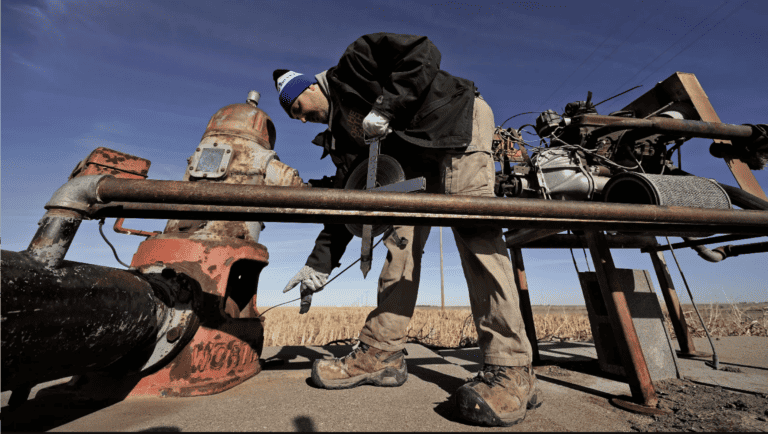A researcher measures water levels in an irrigation well near Marienthal, Kansas. Water levels in the state’s Ogallala Aquifer have been declining for decades. AP Photo / Charlie Riedel
With little fanfare, the administration is using infrastructure funding to revive dormant plans for pipelines and reservoirs in rural areas across the U.S. West.
Water is hard to come by on the Rocky Boy’s Reservation, and it has been for a long time. The Chippewa Cree tribe members who live on this reservation in north-central Montana get most of their water from a thin underground aquifer that is insufficiently replenished by occasional rainfall, and they’ve been under some form of water restriction for several decades. There’s only enough groundwater for cooking and hygiene, so residents aren’t allowed to water their yellowing lawns or run sprinklers. It’s illegal to operate a car wash.
“It’s been in place for most of my life,” said Ted Whitford, the director of the tribe’s water resources department. “And if we get a water main break on our main line, what happens is it drains the tanks, and pretty much puts everyone that’s on that system out of water.”
When the tribe reached a deal to obtain water rights for the reservation in 1997, the federal government agreed to pipe in water from a reservoir on the Marias River, almost 60 miles away, replacing the aquifer water. But for more than 20 years, that project proceeded at a crawl, with the government spending only enough money each year to build a small portion of the pipeline. In the meantime, the reservation’s water problems grew more dire with every spell of drought.
That changed last year. The federal Bureau of Reclamation, flush with money from the bipartisan infrastructure bill that Congress passed in 2021, directed $57 million to the Rocky Boy’s Reservation for the project. This year, the Bureau spent another $77 million, allowing construction crews to complete a new water treatment facility at the reservoir and build several miles of pipeline, extending the project closer to the reservation. In the coming years, the feds will pay more than 90 percent of the total project costs.
“When I became familiar with the project, in my mind, it was doomed from the beginning because it was a project that was scheduled to be completed over a 40- to 50-year period,” said Whitford. “We were getting spoon-fed funding. Now we can accelerate that process.” While he once doubted […]
Full article: grist.org

